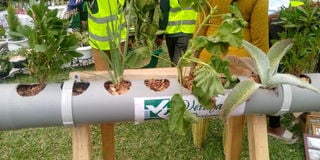Easy ways to create a vertical garden wall

The recycled PVC that are used as planters. PHOTO/Esther Bridget Nakalya.
What you need to know:
These gardening systems are not just practical for people who live in confined spaces but can also add structure and beauty to a spacious garden
Vertical gardening systems can be defined as any type of support or structure that is used to grow plants up and off the ground such as obelisks, pergolas and arbors, tower gardens or wall planters. These gardening systems are not just practical for people who live in confined spaces but can also be used to add structure and beauty to a spacious garden.
Vertical container garden systems
In 2018, Duncan Twesigye decided to take traditional container gardening to whole new heights by combining it with vertical gardening.
Under the innovative village MOTIV based in Bugolobi, a Kampala suburb, Twesigye and his colleagues started recycling plastic such as PVC, HDPE to create affordable and sustainable gardens, especially for space-strapped homes.
With just silicon glue, drills, water tap, wood stand, saw dust, heat, filters and nails, Twesigye is able to come up with some fun and unusual vertical gardening systems. He says it takes about two days to make a 1.2m area planter with two-feet spacing.
“We also make planters from wooden materials and each planter of about 1.1m costs about Shs 250,000. These can help home owners to grow enough spices and vegetables instead of having to buy them,” he explains.
Tumwesiye recommends these gardens for anyone who wants to dress up a boring blank wall or fence in your yard, or you want to add some bright and unique living art to your balcony, deck or patio. The plants, vegetables or herbs are determined by the position of your structure.
“Some plants grow too wild and to be grown vertically as they end up blocking light and interfering with aeration. Alternatively, vine-covered trellises to screen a bad view, define a space and act as a sound barrier,” he says.
Trellises
Trellis structures are the commonest type of plant support systems, and they come in many different shapes and sizes. But generally speaking, a trellis is a flat structure that can either be freestanding, or it can be attached to something else such as a planter, a wall or a fence.
Tower gardens
A tower garden is simply a way to describe tall or stacked container gardens. Tower gardens can be anything from a tall structure that is made out of wood, metal fencing or plastic. They can be as simple as a few stacked planters or pots.
Hanging gardens
Hanging gardens can be anything from a few pots or baskets suspended from a hook on a fence, balcony or deck. Or they can be something more complex such as flower pots on a railing, attached to a wall, fence, or other vertical hanging structure. Living walls have become a very popular way to grow different types of plants.
The benefit of hanging gardens, one is able to grow both soil and soilless plants. There is a new wave of interest in growing plants without soil known as hydroponic growing towers.
Some use structures, stones, or other materials to anchor the plants in place. Nutrients are supplied through the water as needed. Planters such as coconut nests, hanging vases, and hanging planters would grace vertical gardening spaces in an aesthetic and rewarding way.
Choice of plants
Choosing the right plant will save you a lot of time and space. Depending on the amount of sunlight, wind, temperature, humidity and structural integrity some plants grow better in vertical conditions. Tumwesigye says spices and herbs such as Turmeric, Black pepper, Cinnamon and Rosemary tend to thrive through these conditions. Use succulents to create a work of living art with their texture, shape, and colour. Annuals add colourful flowers throughout the growing season.





